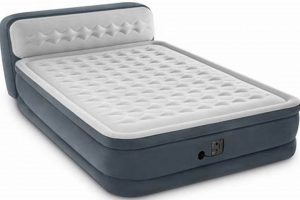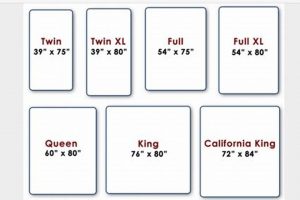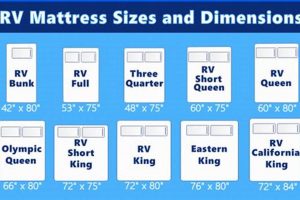Mattress dimensions within the European Union adhere to a set of standardized measurements, differing from those typically found in the United States or the United Kingdom. These dimensions are generally expressed in centimeters, reflecting the metric system’s widespread adoption across Europe. A common example is a standard single mattress, which often measures 90cm wide by 200cm long.
Adherence to these standardized measurements offers significant benefits to consumers and manufacturers. It simplifies the process of sourcing bedding accessories, such as sheets and duvet covers, ensuring a proper fit and minimizing waste. Furthermore, standardized dimensions facilitate international trade and distribution, allowing manufacturers to efficiently serve diverse European markets. Historically, the adoption of these sizes reflects a broader movement towards standardization aimed at streamlining commerce and improving consumer convenience.
Understanding the nuances of these dimensions is crucial when selecting a mattress or related bedding products within the EU. The following sections will delve into specific size categories, explore variations across different European countries, and provide guidance on choosing the optimal size based on individual needs and preferences.
Guidance on EU Mattress Dimensions
The following provides crucial information regarding European Union mattress measurements. Proper consideration of these details ensures informed purchasing decisions and optimal sleep quality.
Tip 1: Understand Common Designations: Familiarize yourself with standard size designations, such as single (90x200cm), double (140x200cm), and king (160x200cm). These measurements can vary slightly between manufacturers and countries.
Tip 2: Consider Sleeper Size and Sleeping Style: Account for the individual’s height and weight. Side sleepers often require more width to accommodate shoulder movement comfortably.
Tip 3: Measure the Bed Frame: Prior to purchase, precisely measure the interior dimensions of the bed frame. Discrepancies between the frame and mattress size can lead to instability and discomfort.
Tip 4: Factor in Room Size: Ensure sufficient space within the bedroom after the bed is assembled. Overcrowding can negatively impact comfort and accessibility.
Tip 5: Research Country-Specific Variations: Be aware that subtle size variations may exist across different EU member states. Verify measurements with the manufacturer or retailer to avoid incompatibility.
Tip 6: Check Mattress Depth: Different mattress types, such as memory foam or innerspring, have varying depths. Account for this when selecting sheets and other bedding accessories.
Tip 7: Consult Customer Reviews: Review feedback from other purchasers regarding size accuracy and overall comfort. This provides valuable insights beyond the manufacturer’s specifications.
Careful attention to these considerations will significantly enhance the likelihood of selecting a mattress that provides optimal support, comfort, and long-term satisfaction.
The succeeding section will provide a comprehensive comparison of various material types and their impact on overall sleeping experience.
1. Single
The “Single: 90cm x 200cm” dimension represents a fundamental component within the broader category of European Union mattress dimensions. It serves as a baseline for understanding the spectrum of available sleeping surfaces designed for individual occupancy within the EU market. A single mattress of this size allows for standardization across manufacturing, logistics, and consumer purchasing. For example, a student moving into university housing in Germany is likely to find that their pre-purchased 90cm x 200cm sheets will fit the provided mattress, ensuring convenience and avoiding additional expense. The consistent availability of this size simplifies the process for furniture retailers and online marketplaces across different EU member states.
The importance of this particular size lies in its suitability for smaller bedrooms and living spaces, common in densely populated urban areas within Europe. Furthermore, healthcare facilities and dormitories often utilize single mattresses of this standardized dimension to maximize space efficiency and facilitate easy maintenance. The adherence to this dimension also streamlines the production process for manufacturers. For instance, a factory in Poland can efficiently produce thousands of mattresses knowing that they will meet the needs of consumers throughout the European market. This mass production drives down costs, making comfortable sleeping solutions more accessible.
In summary, the “Single: 90cm x 200cm” measurement is not merely a numerical value; it signifies a practical and economically significant aspect of European Union mattress standards. While some regional variations exist, this dimension serves as a crucial benchmark for both consumers and manufacturers. Its widespread adoption promotes efficiency, affordability, and convenience, contributing significantly to the overall market for sleeping solutions within the EU. The standardization, however, also presents challenges in accommodating individuals with specific needs, such as those requiring longer or wider mattresses, highlighting the need for options beyond the standard sizes.
2. Double
The “Double: 140cm x 200cm” size represents a significant segment within the standardized European Union mattress dimensions. This specific measurement caters to a demand for sleeping surfaces suitable for couples or single individuals desiring increased space. Its prominence stems from the compromise it offers between the compactness of a single mattress and the larger footprint of king-sized alternatives. The standardization, while beneficial, introduces constraints; individual preferences or unique space requirements might necessitate deviations from the specified measurements, potentially increasing costs and limiting availability. The adherence to the metric system in these measurements directly reflects the dominant system of units utilized across the EU, facilitating both internal commerce and international trade within the bedding industry.
The practical significance of understanding the “Double: 140cm x 200cm” dimension lies in its direct impact on purchasing decisions. For instance, a young couple furnishing a new apartment in France will need to be aware that linens marketed as “double” are typically designed to fit this specific size. Conversely, failing to recognize this standardization could result in the acquisition of ill-fitting bedding accessories, leading to unnecessary expense and inconvenience. The availability of accessories tailored to the standardized size simplifies the consumer experience. It provides a predictable level of interoperability. This dimension also affects manufacturers, ensuring that production lines and distribution networks are optimized for consistent output.
In summary, the “Double: 140cm x 200cm” dimension is a key component of the European Union mattress size standardization. It facilitates efficient production and streamlined consumer purchases. While offering numerous benefits in terms of accessibility and cost-effectiveness, the standardization inherently limits individual customization. The challenges associated with accommodating diverse preferences or spatial constraints underscore the need for a balanced approach. This approach should maintain standardization while providing options that address specific consumer needs within the wider European market. This balance would enhance both the consumer experience and the overall competitiveness of the EU bedding industry.
3. King
The dimension “King: 160cm x 200cm” represents a prevalent standard within the broader category of European Union mattress sizes. Its significance arises from its accommodation of two adults while adhering to space constraints often encountered in European dwellings. This size facilitates consistent manufacturing practices and streamlined supply chains across EU member states. For example, a hotel chain operating multiple locations throughout the EU can reliably source bedding accessories conforming to this specific dimension, ensuring uniformity and reducing logistical complexities. Deviation from this standard, while possible, typically necessitates custom orders and increased costs, impacting both manufacturers and consumers.
The practical application of understanding the “King: 160cm x 200cm” dimension manifests in numerous scenarios. When furnishing a master bedroom, accurate knowledge of this standard enables consumers to select appropriate bed frames and linens. Retailers rely on this standardization to manage inventory and offer compatible products. Consider a couple relocating from Spain to Italy; their existing “King: 160cm x 200cm” bedding is expected to fit a similarly sized mattress purchased in Italy, provided both adhere to the prevailing EU standard. This interoperability, although not absolute due to minor regional variations, greatly simplifies the process of setting up a new home.
In summary, the “King: 160cm x 200cm” dimension is a crucial component of the European Union mattress size ecosystem. Its standardization fosters efficiency in manufacturing, distribution, and consumer purchasing. While acknowledging the existence of regional nuances and the potential for customized solutions, this dimension serves as a reliable benchmark for ensuring compatibility and minimizing logistical challenges within the EU bedding market. However, the continued rise in demand for adjustable beds and specialized mattresses may necessitate further refinement of these standards to accommodate evolving consumer preferences and technological advancements.
4. Super King
The “Super King: 180cm x 200cm” mattress size occupies a distinct position within the broader framework of European Union mattress dimensions. Its dimensions cater to individuals seeking a spacious sleeping surface and represent a significant segment of the premium bedding market across the EU.
- Market Segmentation
The “Super King: 180cm x 200cm” size primarily targets consumers prioritizing comfort and space. This demographic often includes couples who value individual sleeping space and individuals with larger bedrooms. Market research indicates that demand for this size is correlated with higher disposable income and a preference for luxury goods. In Germany, for instance, surveys reveal a growing demand for larger mattresses among affluent households, driving sales of “Super King” models.
- Logistical Considerations
The larger dimensions of “Super King” mattresses present unique logistical challenges for manufacturers and retailers. Transportation costs are higher due to increased volume, and storage requirements are more demanding. Furthermore, delivery to consumers’ homes often requires specialized handling due to the size and weight of the mattress. A furniture store in Spain, for example, might need to employ a larger delivery vehicle and a two-person team to ensure safe and efficient delivery of a “Super King” mattress to an apartment building with narrow hallways.
- Bedding Accessory Standardization
While “Super King: 180cm x 200cm” is a recognized size within the EU, subtle variations in manufacturing can impact the fit of bedding accessories. Consumers should verify the exact dimensions of their mattress before purchasing sheets, duvet covers, and other related products. Retailers often offer bedding specifically designed for this size, but inconsistencies can occur due to variations in fabric shrinkage or stitching tolerances. A shopper in France, for example, might find that a “Super King” sheet set from one manufacturer fits perfectly, while a set from another manufacturer is slightly too small.
- Impact on Bedroom Design
The substantial size of a “Super King” mattress significantly influences bedroom design. It requires a larger bedroom to accommodate the mattress and surrounding furniture comfortably. Interior designers often recommend allocating sufficient floor space around the bed to ensure ease of movement and a visually balanced aesthetic. In Scandinavian countries, where minimalist design principles prevail, the placement of a “Super King” bed is carefully considered to maximize space and light within the bedroom.
The interconnectedness of these facets highlights the importance of understanding “Super King: 180cm x 200cm” within the context of “eu mattress sizes.” Each aspect, from market demand to logistical challenges and design considerations, contributes to the overall position and significance of this specific size within the European bedding market. Awareness of these factors enables consumers to make informed purchasing decisions and allows manufacturers and retailers to optimize their operations to meet the specific needs of this demanding segment.
5. Length Variations (190cm, 210cm)
Within the landscape of European Union mattress dimensions, length variations of 190cm and 210cm represent deviations from the standard 200cm. These alterations address specific consumer needs and spatial constraints, expanding the applicability of standardized sizes.
- Accommodation of Height Differences
The 210cm length primarily caters to taller individuals who require additional legroom for comfortable sleep. Failure to accommodate height can result in discomfort and disturbed sleep patterns. For example, in Scandinavian countries, where a significant portion of the population exceeds the average height, the demand for 210cm mattresses is demonstrably higher. Retailers in these regions stock a wider selection of extended-length options to meet consumer demand.
- Spatial Optimization
The 190cm length provides a solution for rooms with limited dimensions. It allows for the incorporation of a full-sized bed without compromising available floor space. Older buildings with smaller bedrooms frequently benefit from this reduced length. A homeowner in a historic district of Paris, for instance, might opt for a 190cm mattress to maximize the use of a compact bedroom space.
- Manufacturing and Inventory Implications
Length variations introduce complexity into manufacturing and inventory management. Producers must adapt production lines to accommodate multiple sizes, increasing costs. Retailers face the challenge of forecasting demand for non-standard lengths and maintaining adequate stock levels. A mattress factory in Poland may utilize modular production techniques to efficiently switch between producing 190cm, 200cm, and 210cm models.
- Bedding Accessory Compatibility
Significant length deviations impact the compatibility of standard bedding accessories. Sheets and duvet covers designed for 200cm mattresses may not fit properly on 190cm or 210cm models. Consumers must ensure they purchase bedding specifically sized for their mattress to avoid ill-fitting linens and reduced comfort. Online retailers often provide detailed size charts to assist consumers in selecting appropriate bedding for non-standard mattress lengths.
The incorporation of 190cm and 210cm lengths into the array of “eu mattress sizes” reflects a commitment to addressing diverse consumer needs. While these variations introduce complexities in manufacturing and retail, they enhance the overall utility of standardized mattress dimensions within the European market.
6. Country-Specific Deviations
While the European Union aims for standardization, notable deviations in mattress sizes persist across member states. These variations stem from historical preferences, regional manufacturing practices, and differing interpretations of standardized dimensions. Understanding these nuances is crucial for both consumers and manufacturers navigating the European bedding market.
- Historical Legacy
Long-standing traditions in bedding design and manufacturing contribute to size discrepancies. For instance, older properties in certain regions may necessitate narrower mattresses to fit within existing bed frames, reflecting historical building practices. A traditional French farmhouse, for example, might have bedrooms designed for mattress sizes that differ slightly from contemporary EU standards.
- Regional Manufacturing Standards
Variations in manufacturing tolerances and measurement interpretations can result in slight differences in mattress dimensions, even when adhering to nominally standardized sizes. A “double” mattress manufactured in Italy might differ by a few centimeters from one produced in Sweden, due to differing manufacturing processes and quality control standards. Such subtle differences can affect the fit of bedding accessories.
- Consumer Preferences
Localized consumer preferences regarding mattress size and firmness also influence market offerings. In some countries, there may be a stronger preference for larger mattresses, leading to a greater availability of “Super King” or custom sizes. German consumers, for example, are known to prefer firmer mattresses, which impacts the internal construction and overall dimensions.
- Marketing and Naming Conventions
Marketing and branding strategies can introduce further confusion. The term “double” or “king” might not consistently correspond to the standardized measurements across different countries. A retailer in Spain may market a mattress as “king size,” but its dimensions could vary from the standard “King: 160cm x 200cm” size, requiring careful verification of the actual measurements.
These country-specific deviations highlight the complexities within the ostensibly standardized “eu mattress sizes.” While the EU strives for uniformity, the interplay of historical factors, manufacturing practices, consumer preferences, and marketing conventions results in a fragmented landscape. Manufacturers and consumers must exercise diligence in verifying dimensions to ensure compatibility and satisfaction, recognizing that the label alone may not guarantee adherence to a singular, consistent standard.
7. Bed Frame compatibility
Bed frame compatibility is inextricably linked to European Union mattress sizes. Proper alignment between these elements is fundamental for structural integrity, safety, and optimal sleeping experience. Discrepancies can lead to instability, reduced mattress lifespan, and compromised user comfort.
- Standardized Dimensions and Internal Frame Measurements
Bed frames must correspond to the standardized “eu mattress sizes,” reflecting the specified length and width in centimeters. Internal frame measurements, representing the recess designed to house the mattress, are critical. A bed frame intended for a 160cm x 200cm “King” mattress must accurately accommodate these dimensions. A discrepancy, even a few centimeters, can result in the mattress shifting during use or failing to receive adequate support. For instance, purchasing a frame with slightly smaller internal dimensions forces the mattress to compress, potentially damaging its internal structure.
- Slat Support Systems and Weight Distribution
Slat support systems, commonly constructed from wood or metal, play a critical role in weight distribution. The spacing and strength of slats must be appropriate for the size and type of mattress used. Insufficient or improperly spaced slats can lead to sagging and uneven wear, especially with heavier mattresses. A “Super King: 180cm x 200cm” mattress requires a robust slat system to distribute weight effectively and prevent premature degradation. A failing support system can also void warranty coverage on some mattress types.
- Headboard and Footboard Integration
Headboard and footboard design impacts compatibility, particularly with regard to mattress height. The visible portion of the headboard can be obscured if the mattress is excessively thick. Conversely, a thin mattress may leave an undesirable gap. Furthermore, some bed frames incorporate features like recessed panels or decorative elements that can interfere with the fit of certain mattress types. Prior verification of mattress depth in relation to headboard height is essential for achieving the desired aesthetic.
- Platform Bed Considerations
Platform beds, characterized by a solid or closely-spaced slatted surface, eliminate the need for a separate box spring. However, proper ventilation is crucial to prevent moisture buildup and mold growth. A platform bed designed for a specific “eu mattress size” must provide adequate airflow beneath the mattress. Certain memory foam mattresses, known for retaining heat, are particularly susceptible to moisture accumulation on a non-ventilated platform, potentially reducing lifespan and affecting hygiene.
In conclusion, bed frame compatibility is not merely a matter of matching nominal dimensions. It encompasses a range of factors, from internal frame measurements to slat support systems and ventilation considerations. A comprehensive understanding of these elements is necessary to ensure structural integrity, prolong mattress lifespan, and achieve optimal sleeping comfort within the context of “eu mattress sizes.” Failure to consider these factors can lead to premature wear, reduced support, and potential health concerns.
Frequently Asked Questions Regarding EU Mattress Dimensions
The following addresses common inquiries concerning mattress measurements within the European Union. Precision in this area ensures optimal purchase decisions and compatibility with existing bedroom furnishings.
Question 1: What are the standard single mattress dimensions within the EU?
A standard single mattress typically measures 90cm wide by 200cm long. Variations of this exist, particularly in length, but these dimensions represent the most common configuration.
Question 2: How do EU double mattress sizes compare to those in the United States or United Kingdom?
EU double mattress sizes differ significantly. A standard EU double is 140cm x 200cm, whereas sizes in the US and UK are often wider and shorter. Careful measurement conversion is essential when purchasing bedding internationally.
Question 3: Are there variations in mattress sizes across different EU countries?
Yes, subtle variations exist. While the metric system is standard, interpretation and manufacturing tolerances can result in slight differences. Verification of dimensions with the manufacturer is advisable.
Question 4: How does one account for mattress depth when selecting bedding?
Mattress depth varies depending on construction. Measure the mattress depth and ensure that fitted sheets accommodate this dimension. Deep-pocket sheets are available for thicker mattresses.
Question 5: What considerations are relevant when selecting a mattress for a bed frame purchased outside the EU?
When combining bed frames and mattresses from different regions, precise measurement is paramount. Note any discrepancies between metric and imperial units and ensure internal frame dimensions align with the selected mattress.
Question 6: How does mattress length impact sleeping comfort and support?
Insufficient mattress length can compromise support and comfort, particularly for taller individuals. Adequate legroom is essential for proper spinal alignment and restful sleep. Consider a longer mattress if height exceeds the standard 200cm.
Accurate knowledge of dimensions is critical to navigate the European Union mattress market effectively. These FAQs provide essential guidance for consumers and industry professionals alike.
The subsequent section will analyze mattress material types and their impact on sleep quality.
Conclusion
This analysis of “eu mattress sizes” has elucidated the complexities inherent in a seemingly straightforward aspect of consumer goods. The discussion has encompassed standardized dimensions, country-specific variations, and compatibility considerations, underscoring the need for precision and informed decision-making. Factors such as sleeper height, room dimensions, and bed frame specifications must be carefully weighed to ensure optimal comfort and utility.
A comprehensive understanding of these dimensions is thus essential for both manufacturers and consumers navigating the European bedding market. Continued diligence in adhering to established standards, while remaining cognizant of regional nuances, will facilitate a more seamless and satisfactory experience for all stakeholders. Future advancements in mattress technology and design may necessitate further refinement of these dimensional standards to accommodate evolving needs and preferences.







![Best Queen Size Mattress with Boxspring [Deals!] Organic & Natural Mattress Buyer’s Guide: Non-Toxic Sleep Solutions Best Queen Size Mattress with Boxspring [Deals!] | Organic & Natural Mattress Buyer’s Guide: Non-Toxic Sleep Solutions](https://mattressworldpa.com/wp-content/uploads/2025/07/th-2253-300x200.jpg)